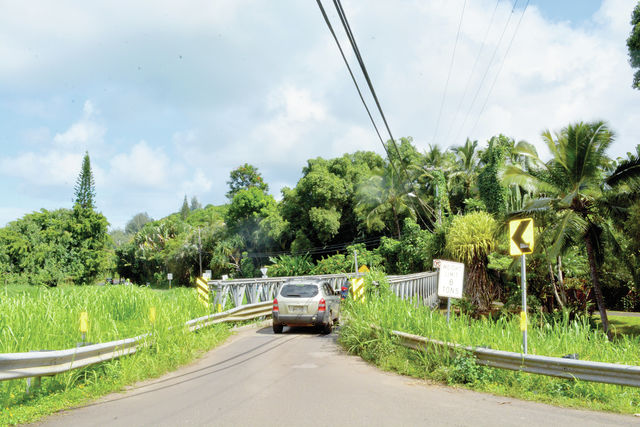Considering bridge replacement
WAINIHA — Over the decades, Mother Nature has been pretty tenacious about breaking down the three bridges that cross Wainiha Stream on Kuhio Highway. Once again, there’s talk about replacing them.
The Hawaii Department of Transportation and the U.S. Department of Transportation Federal Highway Administration (FHWA) have released a draft environmental assessment on the estimated $25 million project.
A public meeting was held Tuesday evening in the Hanalei School cafeteria to bring the public up to speed on the project.
“The primary purpose of the project is to replace the three temporary Wainiha bridges and to maintain continued long term access along Kuhio Highway,” said Shelly Kunishige, with HDOH.
Kunishige said the secondary goals of the project are “improving safety and operations, managing maintenance, and balancing the improvements with the character of the historic highway.”
The bridges that currently span the stream are just temporary structures, one installed in 2004 and the other two in 2007. Kunishige said they were installed because the original bridges were hammered by weather and waves since the creation of the first one in 1904.
The original timber through-truss, one-lane bridges were hit by tidal waves in 1946 and in 1957. The east span of bridge three collapsed in 1966. As they were repaired, the bridges took on the steel truss, timber-decked style of the 1950s and 1960s before they were again taken out by storms and structural failures in 2004 and 2007.
In both those years, Gov. Linda Lingle signed proclamations delaying permanent repairs in order to balance safety requirements with preserving the historic nature of the single-lane bridges.
And so, the bridges were replaced with prefabricated, modular steel bridges, located between mileposts 6.4 and 6.7, near the mouth of the Wainiha Stream.
“The temporary bridges were put in place to ensure critical access to the community while design and compliance work for the permanent structures was being completed,” Kunishige said. “The intent was always to replace the temporary bridges with permanent structures.”
According to the draft environmental assessment, the new bridges would “closely match the existing horizontal roadway alignment,” and their construction would fix some of the existing operational and maintenance problems.
“Ancillary work involving temporary crossings (bridges) for construction equipment access may be needed, but the focus of the project is the replacement of the Wainiha Bridges,” Kunishige said.
In order to access the three Wainiha bridges, according to the draft environmental assessment, three different, load-restricted bridges must be crossed. Those three bridges cross the Waioli, Waipa and Waikoko streams, and they “may not be able to accommodate construction loads,” the overview states.
FHWA outlines alternatives, such as temporary bridges or supplemental supports to the existing bridges, as options to remedy the problem in their project overview.
The overview cites 2010 traffic data, which showed average daily traffic at approximately 3.790 vehicles per day. People are usually headed to or from Haena and Hanalei, Ke’e and the Kalalau Trailhead.
Kunishige said any impacts to the public will be communicated through news releases and social media.
“Impact to the public would be in the form of minor delays and short-term closures needed to ensure construction and equipment does not pose a threat to the traveling public, and that construction crews have the access they need to work safely,” Kunishige said.
Those with questions on the report can call Michael Will at (720) 963-3647. Comments on the project’s draft environmental assessment can be sent via email to Michael.will@dot.gov or via mail to Michael Will, FHWA-CFLHD, 12300 W. Dakota Ave., Suite 380, Lakewood, CO 80228.

